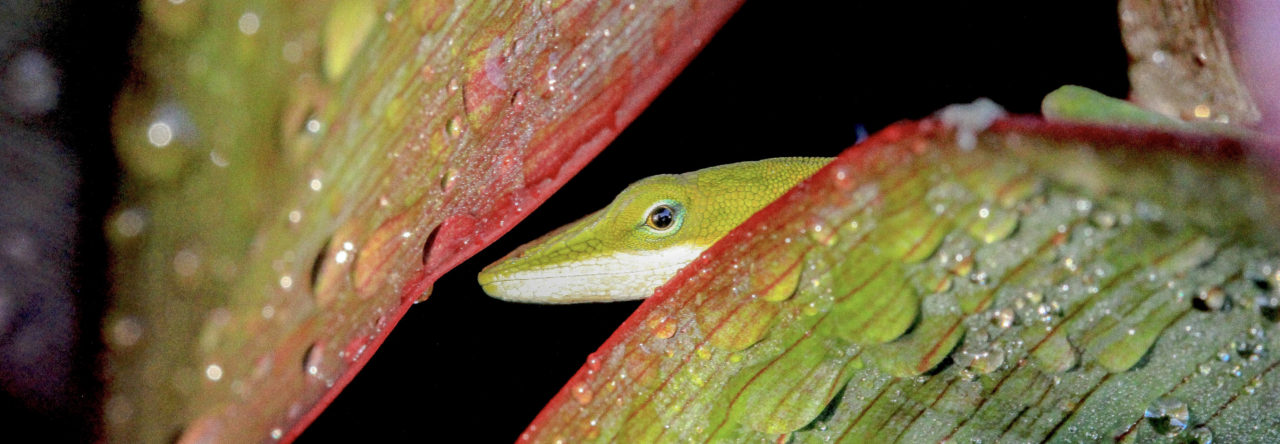George Gorman, who pioneered the use of molecular tools to study anole phylogenetics from the late 1960’s to the early 1980’s, asks:
“Why not examine karyotypes of Dactyloa?”
He says:
“In the 1960’s and ‘70’s, before the DNA revolution, the systematic examination of karyotypes of reptilian taxa mushroomed, and, to some extent helped orient our thinking about relationships among various clades. This was certainly the case within Anolis at various hierarchical levels, from species determination to definition of distinct species groups. To my knowledge, there has been very little added to our knowledge about karyotypes of mainland Anolis that Etheridge placed in the latifrons series of Alpha Anolis, now frequently referred to as the Dactyloa clade. (if these are long-lost terms, Etheridge’s Beta anoles are the Norops section; all other lineages are within his “Alpha” section).
Background
There is a very pervasive, either primitive or convergently arrived at, karyotype among the Sauria…consisting of 12 metacentric macrochromosomes, and 24 microchromosomes. This karyotype may be found in many families and in all species of many genera within families. This was also the known published karyotype of A. carolinensis….the only anole that had been examined until about 1965.
Here’s a brief summary of what followed:
This “typical” karyotype turns up in cybotes, chlorocyanus, coelestinus, and I believe semilineatus and olssoni (i.e., much of the Hipaniolan radiation). It is also found in Cuban “alpha” anoles, sometimes with minor modification, such as loss of a pair of microchromosomes. Species that I remember looking at were allisoni, bartschi, vermiculatus, porcatus, and some members of the equestris group. It also turns up in cuvieri and occultus (but nothing else on Puerto Rico).
Where it turns up, it’s not especially interesting…an apparent shared primitive condition. It also characterizes the Lesser Antillean roquet group (with a loss of a pair of microchromosomes in one lineage). These are generally treated as Dactyloa.
This karyotype NEVER turns up in so-called Norops or Beta anoles… They have a highly derived karyotype. And it never turns up in Etheridge’s so-called bimaculatus group (the northern Lesser Antillean radiation, plus acutus, distichus, evermanni). Similarly, it is not found in the cristatellus radiation (once we remove the cybotoids from cristatellus).
SO…we’ve now accounted for the entire Caribbean plus the mainland Norops.
And what we see is that when the karyotype is NOT the 12 metacentric macros and 24 (or 22) micros, it is often radically different. Karyotype helped to define species groups, and to distinguish some subgroups within species groups (e.g. scriptus shares a derived karyotype with cristatellus; cooki does not). Thus we’re left with the largely unstudied “Mainland Alpha” radiation. Back in the day, we assumed that this radiation was “primitive”…and I expected to find the “typical” karyotype that one finds in the roquet group. Anolis agassizi of Malpelo Island and A. squamulatus appear to fit this pattern. But, A. jacare appeared to have only 32 chromosomes, and possibly odd sex chromosomes (Williams, Reig, Kibilsky and Rivero-Blanco, in a 1970, Breviora paper; and A. frenatus had 36 chromosomes…but a different arrangement in terms of chromosome size (written up in the Malpelo paper and compared with agassizi).
Thus, two of the four non-roquet Dactyloa species sampled,differed from “typical.” Since the relationships of mainland Dactyloa until recently were poorly understood, I suggest that a quick survey of karyotypes might be a productive way to look for clues for identifying posssible natural groups.
Apologia….this was written at the behest of the esteemed Dr. Losos, from memory, and without consulting the literature. The point is simply to encourage a quick and dirty cytotaxonomic survey of mainland Dactyloa. There may be some insights to be gained, and, at minimum, a publication or two for somone’s resume.
- Evolution in Real Time on Lizard Island - March 23, 2025
- Spider Snags Adult Anolis osa - March 22, 2025
- An Homage to the Green Anoles of New Orleans - March 21, 2025



1 Pingback